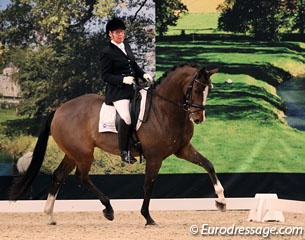
When we begin competition we typically start at the lower levels, where we can sort of fudge our way around without really having to concentrate on every step. When you reach the higher levels or your horse gets more impulsion and hopefully more ground coverage, we begin to realise just how small the 60x20 arena really is.
One of the fundamental tools a top rider has in their toolbox is the ability to prepare, execute, and re-balance their horse in the corner; allowing them to come into the next exercise with the correct rhythm, straightness, activity and impulsion.
I was watching the top riders execute their corners during the test and I was amazed to see how far they manage to actually go into the corners. The term "deep" doesn't really cut it and, if you watch closely, it's almost as if they get right to the top and do a 180 degree flip to take the new side.
Then I thought about how I was riding my corners, realising that I was more or less making a short-cut comma dive onto the inside shoulder and then waking up at C thinking ''how am I going to prepare that 'halt at C and reinback' that was supposed to happen right now?"
Mexican O-Judge Maribel Alonso advises that riding corners properly means showing correct bending, uniform longitudinal flexion and self carriage. Nuno Oliveira also used to tell riders that "when riding laps in the arena, consider each of the four corners as a little piece of shoulder-in." It's through this art of correct bending, that according to Maribel, the horse increases the engagement of the inside hindquarters. "This is what, in my opinion, skillful riders are able to show," she added.
Defining each corner as a quarter of a circle or volte, depending on the level, Maribel states that a well ridden corner not only shows a straight horse on a curve line, but also shows balance and suppleness. "When the corner is well ridden, the horse seems to float smoothly, increasing suspension, whilst maintaining the pace and cadence. In achieving this both the rider’s seat and the contact becomes lighter."
If you can master the art of the corner, this not only gives riders more time, but also enables them to rebalance and engage the horse. "Corners give riders more room to prepare for the next exercises, yes, but they also allow for the use of half-halts to regain any balance that the horse might have lost throughout the previous exercises," Alonso explained. "Furthermore it offers the rider the chance to bring the shoulders fore, thus preventing the hindlegs from falling out. The support of the wall enables riders to use more inside leg and rein to obtain lateral flexion; this in turn will compel the use of the outside rein and leg to keep the hindlegs in place."
Maribel added that riders with less experience will waste this opportunity and lose marks because they cannot properly prepare for the next exercise. However, even good riders can have trouble with corners, particularly if the horse is also learning the art of the corner. "Horses have a stiff and a hollow side, so one of the challenges in training is to make the horse flexible to both sides as symmetrically as possible. As the horse's flexibility increases, so will its contact on both reins. This flexibility is evident in the way the rider maintains the contact and balance in circles, voltes and corners. This is even more obvious in the Grand Prix level."
Often riders fall into the corner traps of counter-bending, or cutting the corner off, which not only results in lower marks for that exercise but also a drop in the collective marks as the training scale will not have been properly fulfilled. "Straightness is one of the major elements of the dressage training scale and ultimately the bottom line is that a horse always needs to show straightness, whether it is on a straight or a curved line," said Maribel.
German Olympian Ingrid Klimke has ridden many corners in her time and her experience in the jumping world only fine-tunes her expertise and her appreciation of the all important corner. "To ride a good corner in a test one must sit in balance and make sure that the diagonal aids (outside hand and inside leg) are working effectively together," said Ingrid.
The expert tip from the top rider is, in the case of approaching a corner from the diagonal, to make sure that you do not arrive at the outside exactly at the letter, but instead try to make a line about one meter in from the corner to give your horse more room to make the turn. "You must then be able to give and feel in a forward motion with your inside hand while you turn in the corner, and sit on you inside seatbone," said Klimke.
British Olympic gold medalist Charlotte Dujardin knows that the corners set you up to perfect the movements to follow. She learnt to ride her corners so well, through non-stop practicing. "Start by trotting into the corner, walking round it and trotting out until the horse is bent around your leg," Dujardin explained. "Then continue this exercise just in trot, leave out the walk unless a mistake is made. If a mistake appears, return to the basic exercise of trot in, walk round and trot out until you feel ready to try trot again."
Hopefully with all that advice and constant practicing, we will avoid that awkward C ("oh my god I'm here") arrival and instead set ourselves up for a balanced and rhythmic dance across the short side.
by Sarah Warne for Eurodressage
Photo © Dirk Caremans
Related Link
Sarah Warne's Classical Training Articles